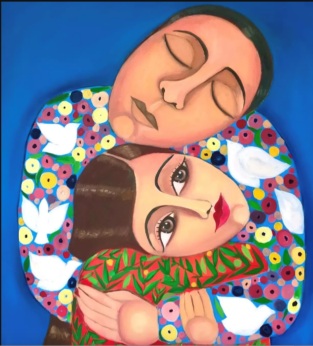Image via PW
Reposted from Peoples World
This year the Quais du Polar in Lyon, the largest European festival of crime novels and one of the largest in the world, in celebrating its 20th season, was marked by the intrusion into the spine of the novels by the real-world problems and catastrophes going on around the festival.
Each evening, just outside the festival walls, in front of the town hall, there was a vigil calling for a ceasefire in Gaza, while inside there were novelists incorporating climate apocalypse, rabid income inequality, and the indignity of European cities, most notably Venice and Barcelona, overcome by tourism.
In a panel on encouragement of reading sponsored by UNESCO’s “Creative Cities” initiative, the Icelandic crime writer Yrsa Sigurðardóttir, who ought to know since she not only helped create and chair the Reykjavik Crime Fiction Festival but has written 15 novels, explained that Iceland has money to give to support all kinds of arts because it is one of the few countries in the world that “doesn’t have an army.” She suggested, and not totally facetiously, that instead of destroying each other on the battlefield, Russia’s Putin and Ukraine’s Zelensky instead should duel it out by writing alternate chapters of a novel. Such an initiative is sponsored each year as two crime writers come together to do just that. This year’s work is The Steve McQueen which quotes the film The Thomas Crown Affair, which starred McQueen, since both are about heists that go awry. The novel is authored by Lyon’s Caryl Férey and Northern England’s Tim Willocks, whose his most famous book, however, Bad City Blues, is set in New Orleans.

This year’s work is The Steve McQueen about a Thomas Crown Affair, a film which starred McQueen, heist that goes awry authored by Lyon’s Caryl Férey and Tim Willocks whose most famous book Bad City Blues is set in New Orleans though he is from the north of England.
A panel innocuously celebrating cooperation between France and Britain initiated in the Entente Cordial signed in 1904 that ended several centuries of armed conflict, took on a contemporary air when Peter May recounted why he had come out of retirement to write A Winter Grave, a crime novel set in 2051. In this nightmarish future, the Scottish Highlands are frozen, but thawing enough so a dead body is discovered in an icy cave while Glasgow is flooded, filled with acrid odors from the backed-up sewers, with cars replaced by Venetian-style water taxis. May related that after COP26, the 2021 Glasgow Climate Conference, which he attended, he became convinced that the destruction of the earth was not going to be addressed. He was so shocked by this cavalier attitude that he wrote a book in which the context that surrounds the mystery is a failing earth where two billion people are forced to flee their homes.
He was not the only writer to address this issue. One panel focused on dystopic worlds to come, a subject that had previously not been central to the crime novel, which has always been an excellent way of highlighting contemporary and past corruption but has generally steered clear of the science fiction predilection with the future, a sign that the climate crisis is intruding everywhere.

Back in the present again, the devastating effects of fossil fuel and mineral extraction showed up as Karin Smirnoff, who is now charged with continuing Steig Larson’s Millennium series with The Girl in the Eagle’s Talons, explained that her sequel is set in the north of Sweden, home of Europe’s last Indigenous population, the Sami, where mining interests unearthing material for clean energy batteries often claim they can drill and dig on the land because “nobody lives there.” Smirnoff, the first female to write a volume of a series which is now subtitled “A Lizbeth Salander Novel,” pointing to the popularity of the female character, explained by way of her book that a good deal of harm is done to Indigenous lands in the name of safe and clean energy, where to get access to the minerals powering batteries the companies “kill six lakes surrounding the mine.”
A panel on white collar crime suddenly took an unexpected turn when the Italian mystery writer Valerio Varesi, whose novels are set in Parma in Northern Italy’s Po Valley, explained that his subject is the change in his town in the wake of the Reagan-Thatcher ’80s. It was at that point that he observed the market economy driving human behavior and the thirst and need for money and profits beginning to dominate human relationships. Varesi, who is also a journalist for La Repubblica, explained that after the economic crash of 1929, banks and the financial sector were governed by rules that have since been evacuated, allowing the second crash of 2008. His latest, The Lizard Strategy, recounts the eerie disappearance of Parma’s mayor just as he is about to be the subject of a corruption investigation. In light of the penetration of capital into all forms of life, he asked the panel a pointed question: “Who governs Europe, Christine Lagarde (president of the European Central Bank) or Ursula von der Leyen (president of the European Parliament)?” The rest of the panel refused to take up the question and the moderator ordered Valerio not to pursue the subject further.
A regular guest at the festival is France’s most popular crime writer Michel Bussi, whose novels are often diverting page turners but who this year appeared at the conference with his latest, My Heart Has Moved, which confronts the problem of increasing inequality in his town of Rouen. Bussi is a political geographer turned novelist and he explained that the town is now more strictly segregated into the rich more conservative right bank and the poor more radical left bank with the schools on the former now much less open to students from the latter. His novel is about the lifelong quest of a boy whose mother is murdered seemingly by his working-class father but who then discovers that the apparent truth may not be the case.

Venice’s Donna Leon talked about another kind of interpenetration of capital into the lives of the city’s dwindling number of actual citizens who live there, with roughly 50,000 residents overwhelmed by the 30 million people who visit each year. Her inspector Brunetti, she said, does not operate in the land of the tourists but rather pursues his cases by interacting with the still remaining locals, where he often unearths corruption amid what she called “the most beautiful city in the world.” She cited two examples. The first being the often-proposed tourist fee as a way of limiting visitors to the city by fining them if they do not have a permit. She described this as “unenforceable” because of the many ways of accessing the city and the limited number of officials verifying the passes and thus simply designed to appease public opinion. A greater scandal she discussed is the again often cited project of a bridge from Sicily to the mainland which has already consumed millions and which, if it is completed, she hinted, would greatly facilitate traffic from organized crime to the mainland.
One of the guests of honor was John Grisham whose new novel The Exchange is a sequel 30 years later to his second and breakthrough novel The Firm. He recounted how The Firm came to be published as a story that might inspire younger writers. His first book, A Time To Kill, later a publishing success and a film, did not do well when it was initially published. He wrote the second and figured if it stiffed also, he would resign from writing and continue his law career. The book at first got no traction but happened to make its way to Hollywood where it became a sensation and prompted a bidding war among three top studios before being sold to Paramount. With that success, the book then also was the subject of a publishing house auction and he was on his way.
Asked if he himself ever was in fear of the Mafia because of the exposé in the original of a law firm controlled by the mob, he said he wasn’t but that he had gotten a letter from the at that time Mafia godfather John Gotti who was in jail for life and “had plenty of time to read.” Gotti wrote that he really enjoyed the book but that the author “had gotten the parts on the mob all wrong.” Grisham said he wanted Tom Cruise to play the character—who is now aged 40—in the sequel since Cruise is over 60 but “doesn’t look a day over 30.” He said the character Mitch is inextricably linked to Cruise and even referred to the character once as “Tom.”
In The Girl in the Eagle’s Talon Lisbeth Salander grows up and becomes a mature activist. This year’s Quais du Polar showed that the crime film, long a staple of exposing graft and corruption, is growing up as well and taking on the steadily accumulating and disturbing problems of an ever more complex world.
We hope you appreciated this article. At People’s World, we believe news and information should be free and accessible to all, but we need your help. Our journalism is free of corporate influence and paywalls because we are totally reader-supported. Only you, our readers and supporters, make this possible. If you enjoy reading People’s World and the stories we bring you, please support our work by donating or becoming a monthly sustainer today. Thank you!
Dennis Broe, a film, television and art critic, is also the author of the Harry Palmer LA Mysteries, the latest volume of which, The House That Buff Built, is about the real estate industry, dispossession, and appropriation in the shaping of “modern” Los Angeles.


































